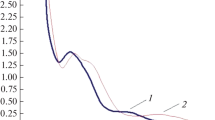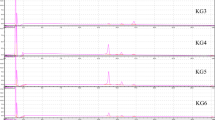Abstract
The aim of the study was to confirm the presence of rutin, one of the most common quercetin glycosides, and other quercetin derivatives in plants of genus Amaranthus, to investigate the influence of the species and variety on rutin distribution in the plant and content changes during growing season. The rutin content was determined by micellar electrokinetic capillary chromatography in individual plant parts at the beginning of the growth, at the flowering stage and at the maturity stage of five Amaranthus species. The total quercetin content was determined by micellar electrokinetic capillary chromatography too. The rutin content in amaranth ranged from 0.08 (in seeds) to 24.5 g/kg dry matter (in leaves). Comparison of the determined total quercetin content and the calculated content of quercetin released from rutin did not prove important presence of quercetin or other quercetin derivatives than rutin. Only amaranth leaves sampled at the maturity stage probably contained quercetin or quercetin derivatives. Significant differences in the rutin content were established among species and as well varieties. Amaranthus hybrid and A. cruentus were the best sources of rutin.


Similar content being viewed by others
References
Yanez E, Zacarias I, Granger D, Vasquez M, Estevez AM (1994) Chemical and nutritional characterization of amaranthus (Amaranthus cruentus). Arch Latinoam Nutr 44(1):57–62
Escudero NL, De Arellano ML, Luco JM, Gimenez MS, Mucciarelli SI (2004) Comparison of the chemical composition and nutritional value of Amaranthus cruentus flour and its protein concentrate. Plant Foods Hum Nutr 59:15–21. doi:10.1007/s11130-004-0033-3
Czerwinski J, Bartnikowska E, Leontowicz H, Lange E, Leontowicz M, Katrich E, Trakhtenberg S, Gorinstein S (2004) Oat (Avena sativa L.) and amaranth (Amaranthus hypochondriacus) meals positively affect plasma lipid profile in rats fed cholesterol-containing diets. J Nutr Biochem 15(10):622–629. doi:10.1016/j.jnutbio.2004.06.002
Martirosyan DM, Miroshnichenko LA, Kulakova SN, Pogojeva AV, Zoloedov VI (2007) Amaranth oil application for coronary heart disease and hypertension. Lipids Health Dis 6:1–12. doi:10.1186/1476-511X-6-1
Cai Y, Sun M, Corke H (2003) Antioxidant activity of betalains from plants of the Amaranthaceae. J Agric Food Chem 51:2288–2294. doi:10.1021/jf030045u
Ofitserov EN (2001) Amaranth: perspective raw material for food-processing and pharmaceutical industry. Chem Comp Simul Butlerov Commun 2(5):1–4
Adebooye OC, Vijayalakshmi R, Singh V (2008) Peroxidase activity, chlorophylls and antioxidant profile of two leaf vegetables (Solanum nigrum L. and Amaranthus cruentus L.) under six pretreatment methods before cooking. Int J Food Sci Technol 43:173–178
Kadoshnikov SI, Kadoshnikova IG, Martirosyan DM (2005) Investigation of fractional composition of the protein in amaranth. In: Non-traditional natural resources, innovation technologies and products, Moscow, Russian Academy of Natural Sciences, pp 81–104
Kononkov PF, Gins M, Rakhimov VM, Gins VK, Logvinchuk TM (2004) Amaranth leaves—a valuable material for production of food additives and enriched tea products. Potatoes Vegetables 1:29–30
Gorinstein S, Vargas O, Jaramillo N, Salas I, Ayala A, Arancibia-Avila P, Toledo F, Katrich E, Trakhtenberg S (2007) The total polyphenols and the antioxidant potentials of some selected cereals and pseudocereals. Eur Food Res Technol A 225(3–4):321–328. doi:10.1007/s00217-006-0417-7
Klimczak I, Malecka M, Pacholek B (2002) Antioxidant activity of ethanolic extracts of amaranth seeds. Nahrung 46(3):184–186. doi:10.1002/1521-3803(20020501)46:3<184::AID-FOOD184>3.0.CO;2-H
Zayachivska OS, Konturek SJ, Drozsdowicz D, Konturek PC, Brzozowski T, Ghegotsky MR (2005) Gastroprotective effects of flavonoids in plant extracts. J Physiol Pharmacol 56(1):219–231
Kwon KH, Murakami A, Tanaka T, Ohigashi H (2005) Dietary rutin, but not its aglycone quercetin, ameliorates dextran sulfate sodium-induced experimental colitis in mice: attenuation of pro-inflammatory gene expression. Biochem Pharmacol 69(3):395–406. doi:10.1016/j.bcp.2004.10.015
Mu C, Jia P, Yan Z, Liu X, Li X, Liu H (2007) Quercetin induces cell cycle G(1) arrest through elevating Cdk inhibitors p21 and p27 in human hepatoma cell line (HepG2). Methods Find Exp Clin 29(3):179–183. doi:10.1358/mf.2007.29.3.1092095
Paliwal S, Sundaram J, Mitragotri S (2005) Induction of cancer-specific cytotoxicity towards human prostate and skin cells using quercetin and ultrasound. Br J Cancer 92(3):499–502
Dunnick JK, Hailey JR (1992) Toxicity and carcinogenicity studies of quercetin, a natural component of foods. Toxicol Sci 19:423–431. doi:10.1093/toxsci/19.3.423
Pamukcu AM, Yalciner S, Hatcher JF, Bryan GT (1980) Quercetin, a rat intestinal and bladder carcinogen present in bracken fern (Pteridium aquilinum). Cancer Res 40:3468–3472
International Agency for Research on Cancer (1999) Quercetin. Summary Eval 73:497
Robaszkiewicz A, Balcerczyk A, Bartosz G (2007) Antioxidative and prooxidative effects of quercetin on A549 cells. Cell Biol Int 31(10):1245–1250. doi:10.1016/j.cellbi.2007.04.009
Kalinova J, Dadakova E (2006) Varietal and year changes of rutin content in common buckwheat (Fagopyrum esculentum Moench). Cereal Res Commun 34(4):1315–1321. doi:10.1556/CRC.34.2006.4.274
Dadakova E, Prochazkova E, Krizek M (2001) Application of micellar electrokinetic capillary chromatography for quantitative analysis of quercetin in plant material. Electrophoresis 22:1573–1578. doi:10.1002/1522-2683(200105)22:8<1573::AID-ELPS1573>3.0.CO;2-B
Bushra S, Farooq A (2008) Flavonols (kaempferol. quercetin. myricetin) contents of selected fruits, vegetables and medicinal plants. Food Chem 108:879–884. doi:10.1016/j.foodchem.2007.11.053
Kandil FE, Grace MH, Seigler DS, Cheeseman JM (2004) Polyphenolics in Rhizophora mangle L. leaves and their changes during leaf development and senescence. Trees—Structure and Function 18:518–528
Kalinova J, Vrchotova N, Triska J (2005) Distribution of flavonoids in common buckwheat. In: Proceedings of an scientific conference with international attendence: Safety and quality of raw materials and food, Nitra, Slovakia, November 10, pp 92–95
Mahdavian K, Ghorbanli M, Kalantari KM (2008) The effects of ultraviolet radiation on the contents of chlorophyll, flavonoid, anthocyanin and proline in Capsicum annuum L. Turk J Bot 32:25–33
Yasuda T, Nakagawa H (1994) Purification and characterization of rutin-degrading enzymes in tartary buckwheat seeds. Phytochemistry 37:133–136. doi:10.1016/0031-9422(94)85012-7
Miean KH, Mohamed S (2001) The flavonoids (myricetin. quercetin. kaempferol. luteolin. apigenin) content of edible tropical plants. J Agric Food Chem 49:3106–3112. doi:10.1021/jf000892m
Duke JA (1992) Handbook of phytochemical constituents of GRAS herbs and other economic plants. CRC, Boca Raton, FL
Bilbao MLM, Andrés-Lacueva C, Jáuregui O, Lamuela-Raventós RM (2007) Determination of flavonoids in a Citrus fruit extract by LC-DAD and LC-MS. Food Chem 101:1742–1747. doi:10.1016/j.foodchem.2006.01.032
Kalinova J, Triska J, Vrchotova N (2006) Distribution of vitamin E, squalene, epicatechin and rutin in common buckwheat plants (Fagopyrum esculentum Moench). J Agric Food Chem 54:5330–5335. doi:10.1021/jf060521r
Park BJ, Park JI, Chang KJ, Park CH (2004) Comparison in rutin content in seed and plant of tartary buckwheat (Fagopyrum tataricum). In: Proceedings of the 9th International Symposium on Buckwheat: Advances in Buckwheat Research, RICP, Prague, Czech Republic, August18–22, pp 626–629
Belton PS, Taylor JRN (2002) Pseudocereals and less common cereals. Springer, Berlin
Martirosyan DM, Kadoshnikov SI, Borsukov PA, Kadoshnikova IG, Agababyan EY, Kamalyan NS, Mnatsakanyan VA (2003) Pharmalogical properties of amaranth. Legacy 15:6–10
Gautier H, Diakou-Verdin V, Bénard C, Reich M, Buret M, Bourgaud F, Poëssel J, Caris-Veyrat C, Génard M (2008) How does tomato quality (sugar, acid and nutritional quality) vary with ripening stage, temperature, and irradiance? J Agric Food Chem 56:1241–1250. doi:10.1021/jf072196t
Suzuki T, Honda Y, Mukasa Y (2005) Effects of UV-B radiation, cold and desiccation stress on rutin concentration and rutin glucosidase activity in tartary buckwheat (Fagopyrum tataricum) leaves. Plant Sci 168:1303–1307. doi:10.1016/j.plantsci.2005.01.007
Modi TA (2007) Growth temperature and plant age influence on nutritional quality of Amaranthus leaves and seed germination capacity. Water SA 33(3):369–378
Acknowledgement
This work was supported by the grant MSM 6007665806.
Author information
Authors and Affiliations
Corresponding author
Rights and permissions
About this article
Cite this article
Kalinova, J., Dadakova, E. Rutin and Total Quercetin Content in Amaranth (Amaranthus spp.). Plant Foods Hum Nutr 64, 68–74 (2009). https://doi.org/10.1007/s11130-008-0104-x
Published:
Issue Date:
DOI: https://doi.org/10.1007/s11130-008-0104-x




